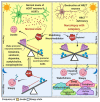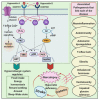Narcolepsy-A Neuropathological Obscure Sleep Disorder: A Narrative Review of Current Literature
- PMID: 36358399
- PMCID: PMC9688775
- DOI: 10.3390/brainsci12111473
Narcolepsy-A Neuropathological Obscure Sleep Disorder: A Narrative Review of Current Literature
Abstract
Narcolepsy is a chronic, long-term neurological disorder characterized by a decreased ability to regulate sleep-wake cycles. Some clinical symptoms enter into differential diagnosis with other neurological diseases. Excessive daytime sleepiness and brief involuntary sleep episodes are the main clinical symptoms. The majority of people with narcolepsy experience cataplexy, which is a loss of muscle tone. Many people experience neurological complications such as sleep cycle disruption, hallucinations or sleep paralysis. Because of the associated neurological conditions, the exact pathophysiology of narcolepsy is unknown. The differential diagnosis is essential because relatively clinical symptoms of narcolepsy are easy to diagnose when all symptoms are present, but it becomes much more complicated when sleep attacks are isolated and cataplexy is episodic or absent. Treatment is tailored to the patient's symptoms and clinical diagnosis. To facilitate the diagnosis and treatment of sleep disorders and to better understand the neuropathological mechanisms of this sleep disorder, this review summarizes current knowledge on narcolepsy, in particular, genetic and non-genetic associations of narcolepsy, the pathophysiology up to the inflammatory response, the neuromorphological hallmarks of narcolepsy, and possible links with other diseases, such as diabetes, ischemic stroke and Alzheimer's disease. This review also reports all of the most recent updated research and therapeutic advances in narcolepsy. There have been significant advances in highlighting the pathogenesis of narcolepsy, with substantial evidence for an autoimmune response against hypocretin neurons; however, there are some gaps that need to be filled. To treat narcolepsy, more research should be focused on identifying molecular targets and novel autoantigens. In addition to therapeutic advances, standardized criteria for narcolepsy and diagnostic measures are widely accepted, but they may be reviewed and updated in the future with comprehension. Tailored treatment to the patient's symptoms and clinical diagnosis and future treatment modalities with hypocretin agonists, GABA agonists, histamine receptor antagonists and immunomodulatory drugs should be aimed at addressing the underlying cause of narcolepsy.
Keywords: cataplexy; hypocretin; narcolepsy; sleep cycle disorder; sleep disorder.
Conflict of interest statement
The authors declare no conflict of interest.
Figures



References
-
- Poli F., Overeem S., Lammers G.J., Plazzi G., Lecendreux M., Bassetti C.L., Dauvilliers Y., Keene D., Khatami R., Li Y., et al. Narcolepsy as an adverse event following immunization: Case definition and guidelines for data collection, analysis and presentation. Vaccine. 2013;31:994–1007. doi: 10.1016/j.vaccine.2012.12.014. - DOI - PubMed
-
- Bassetti C.L.A., Kallweit U., Vignatelli L., Plazzi G., Lecendreux M., Baldin E., Dolenc-Groselj L., Jennum P., Khatami R., Manconi M., et al. European guideline and expert statements on the management of narcolepsy in adults and children. Eur. J. Neurol. 2021;28:2815–2830. doi: 10.1111/ene.14888. - DOI - PubMed
Publication types
Grants and funding
LinkOut - more resources
Full Text Sources

